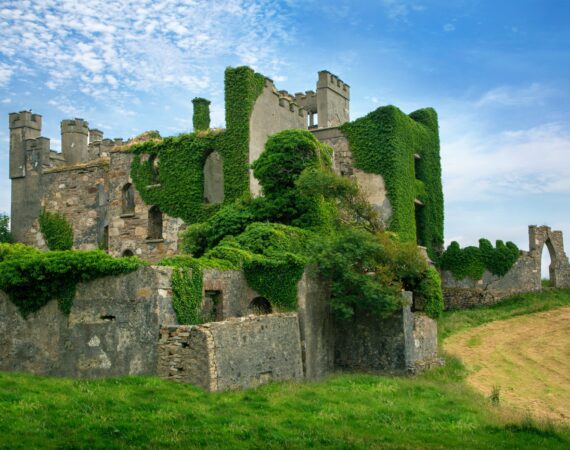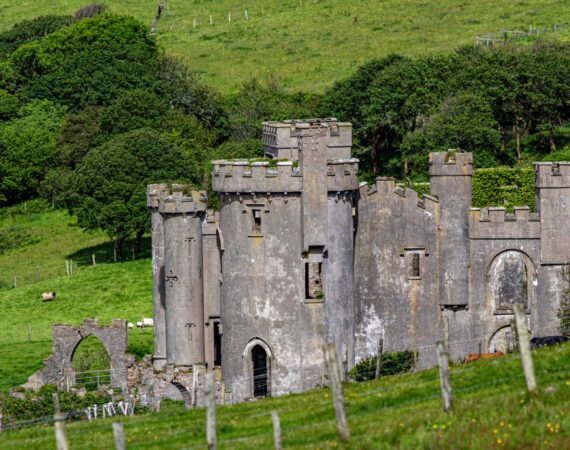Clifden Castle, Co. Galway, Ireland
A Gothic Revival manor built by the founder of Clifden town now stands as a haunting ruin overlooking Clifden Bay, its empty windows bearing witness to famine, bankruptcy, and bitter land disputes.
Clifden Castle, Co. Galway, Ireland
Perched on a hillside west of Clifden town, the skeletal remains of Clifden Castle tell a story of grand ambitions brought low by tragedy. Built around 1818 by John D’Arcy, the founder of Clifden itself, this Gothic Revival manor house once stood at the heart of a 17,000-acre estate in Connemara.
D’Arcy was a man with a vision. While constructing his castle, he was simultaneously building Clifden from scratch, determined to create a commercial hub in this remote corner of County Galway. He brought in the renowned engineer Alexander Nimmo in 1822 to build roads and a quay, connecting his new town to Ireland’s growing infrastructure network. By D’Arcy’s death in 1839, Clifden had grown to over 1,000 residents and was thriving.
The castle itself was built in the fashionable Gothic Revival style, complete with a rounded tower to the southeast, a square tower, and an entry tower with twin turrets. D’Arcy even commissioned decorative standing stones along the approach path – not ancient monuments, but 19th-century follies designed to evoke Ireland’s prehistoric past. A substantial farmyard complex included grain stores, workers’ cottages, stables, and a walled garden. There was even a curious “marine temple” made entirely of seashells beside the eastern stream.
The Fall
When John D’Arcy died in 1839, his son Hyacinth inherited the estate. Unfortunately, Hyacinth lacked his father’s business acumen and struggled with tenant relations. Then came the catastrophe that changed everything: the Great Famine of 1845.
As the potato crops failed and hunger swept through Connemara, the D’Arcy rent income collapsed. On 21 September 1846, desperate tenants gathered en masse on the castle’s front lawn, begging for work or food. The estate went bankrupt, and in 1850 the castle and most of Clifden were sold to Thomas and Charles Eyre, brothers from Bath who had been the estate’s mortgagees since 1837. They paid £21,245 for the lot.
The Eyres used Clifden Castle as a holiday home, adding a new roof in the 1850s and altering the facade to their taste – their family crest still adorns the entrance tower today. As absentee landlords, they kept the property until John Joseph Eyre’s death in 1894. After that, no individual owned the castle, and it fell into neglect.
The Land Wars
The castle’s final chapter reads like something from a western. In 1917, a local butcher named J.B. Joyce purchased the castle and its 200-acre demesne, sparking what can only be described as a land war. Local farmers who had long coveted the land for expansion were furious. The Catholic priest, Canon Patrick McAlpine, launched a fierce campaign from the pulpit, denouncing Joyce as a “land grabber” and ominously predicting he’d soon be six feet under.
The entire town turned against Joyce. Farmers drove his cattle off the land, put their own stock in the fields, and barricaded the gates. A town meeting erupted into violence with stones thrown at police. Even after a judge confirmed Joyce’s ownership in 1920, the harassment continued. Finally, a Sinn Féin arbitration court brokered a deal: Joyce sold the land to a cooperative for £2,300 plus costs.
In 1935, the Land Commission passed ownership to the tenants jointly. With no single owner to maintain it, locals stripped the castle of its roof, windows, timber, and lead. The castle quickly became the romantic ruin it remains today.
Good to Know
Getting There: The castle is 2.5km west of Clifden town along the scenic Sky Road. Look for the medieval-style gateway with its stone archway and towers – it's hard to miss.
Parking: Very limited parking at the gateway entrance with space for about 4 cars. Please don't block the entrance.
Access: Free entry, open year-round. Walk through the gateway and follow the old winding road for about 1km to reach the castle, passing D'Arcy's mock standing stones along the way.
Safety: The castle is a dangerous ruin – do not enter the structure itself. Keep children supervised and dogs on leads as livestock often graze the surrounding fields.
What to See: The Gothic Revival ruins with their towers and turrets, the 1815 medieval-style gateway, five decorative standing stones along the approach, remains of the farmyard complex, and spectacular views over Clifden Bay.







